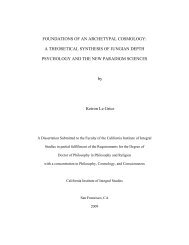The Psychoanalysis of Fire - HEIDI GUSTAFSON
The Psychoanalysis of Fire - HEIDI GUSTAFSON
The Psychoanalysis of Fire - HEIDI GUSTAFSON
Create successful ePaper yourself
Turn your PDF publications into a flip-book with our unique Google optimized e-Paper software.
PS),cho,l11alysis <strong>of</strong> <strong>Fire</strong><br />
which is devouring it, we notice that it does not yield without<br />
resistance, and that it soon recaptures the space that it has abandoned."<br />
,\;{arat might have added, to complete the animistic image<br />
which dominates his unconscious: "Thus dogs return to the prey<br />
from which thev have been driveno1T .<br />
..<br />
This very familiar experience does indeed give us a measure<br />
<strong>of</strong> the tenacity <strong>of</strong> fire in holding fast to what it is consuming. We<br />
need only to try to extinguish a recalcitranc candle from a little<br />
distance away, or to blow oue a flaming punch bowl, to gain a<br />
subjective measure <strong>of</strong> the resistance <strong>of</strong> fire. It is not so rude a<br />
resistance as that <strong>of</strong>fered by inert objects to the touch. For this<br />
very reason it has alJ the more effect in determining the child to<br />
adopt an animistic theory <strong>of</strong> Ere. In every circumstance the fire<br />
shows irs ill will: it is hard to light; it is difficult to pue out. <strong>The</strong><br />
stuff is capricious; therefore fire is a person.<br />
Of course this quickness and this tenacity <strong>of</strong> fire are secondary<br />
characteristics which have been entirely reduced and explained<br />
by scientific knowledge. A healthy abstraction has led<br />
us to neglect them. Scientific abstraction is the cure for the unconscious.<br />
Once it forms the basis <strong>of</strong> OUr education, it brushes<br />
aside the objections that are found scattered over the details <strong>of</strong><br />
experience.<br />
Bue it is perhaps the idea that fire feeds itself like a living<br />
creature which is foremost in the opinions developed about fire<br />
by our unconscious. For a modern mind, to feed a fire has become<br />
a commonplace synonym for keeping it going; but words<br />
dominate us more than we think, and the old image will at times<br />
come back to the mind when the old word comes back to the<br />
lips.<br />
It is nor difficult to assemble a good number <strong>of</strong> texts in<br />
which the food <strong>of</strong> fire keeps its literal primary meaning. A seventeenth-century<br />
author recalls that 8<br />
<strong>The</strong> Egyptians said that it was a ravening, insatiable animal which<br />
devours everything that experiences birth and growth; and, after<br />
64<br />
a<br />
Chemistry ol <strong>Fire</strong><br />
it has eaten well and gorged itself, it finally devours itself when<br />
there is nothing lefe to eat and feast upon; because, having both<br />
heat and movement, it cannot do without food and the air it requires<br />
to breathe.<br />
Vigenere develops his 'w"hole book from rhis initial inspir'1tion.<br />
He finds in the chemistry <strong>of</strong> fire all the chaClcrcrisbcs <strong>of</strong> digestion.<br />
Thus for him, as for many other "vriters, smoke is an excremem<br />
<strong>of</strong> fire. Anmher author, about the same period, writes char9<br />
"the Persians, when they made sacrifices to fire, would present<br />
food to it on the altar wlule uttering this phrase ... 'Eat and<br />
feast, 0 <strong>Fire</strong>, lord <strong>of</strong> all the world.' "<br />
In the eighteenth century, Boerhaave still<br />
. finds it necessary to make clear through a long investigation<br />
what must be understood by' the aliments <strong>of</strong> fire ... If we give<br />
them this appellation in a restricted sense, it is because we believe that<br />
these substances really do senre as food for <strong>Fire</strong>, that through itS<br />
acaon they are converted into the proper substance <strong>of</strong> elementary<br />
<strong>Fire</strong> and that they lay aside their own primitive nature to take on<br />
that <strong>of</strong> <strong>Fire</strong>; in this case we are assuming a fact wruch deserves to<br />
be examined with mature deliberation. lO<br />
And this is what Boerhaave proceeds to do in a great many pages<br />
in which he himself <strong>of</strong>fers a feeble resistance to the animistic<br />
intuition he is seeking to reduce. We are never completely immune<br />
to the prejudice that we spend a great deal <strong>of</strong> time in attacking.<br />
At any rate, Boerhaave saves himself from the animistic prejudice<br />
only by fortifying the substancialist prejudice: in his doctrine,<br />
the food <strong>of</strong> fire is transformed into the substance <strong>of</strong> fire.<br />
By assimilation, the aliment becomes fire. This assimilation <strong>of</strong><br />
substance is the negation <strong>of</strong> the spirit' <strong>of</strong> Chemistry. Chemistry is<br />
able to study the way in which Substances are combined,are<br />
mixed together and remain juxtaposed .. Those are three defensible<br />
notions. But Chemistry cannot study how one substance<br />
assimilates another. When it accepts this concept <strong>of</strong> assimilation,<br />
the more or less learned form <strong>of</strong> the concept <strong>of</strong> food, it throws'<br />
65



